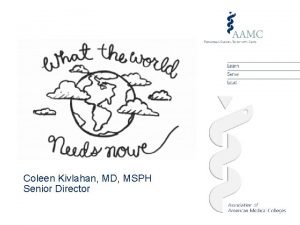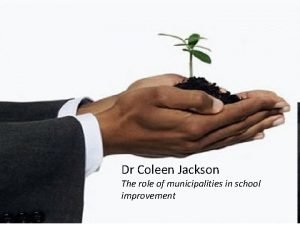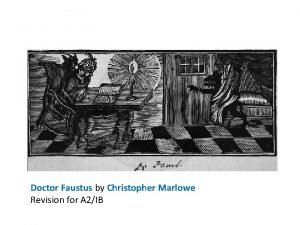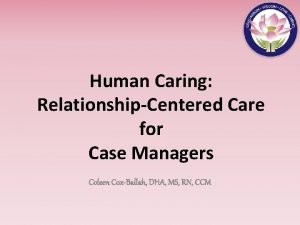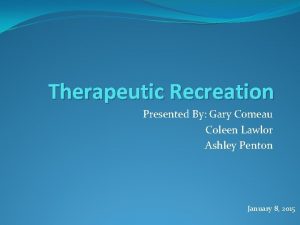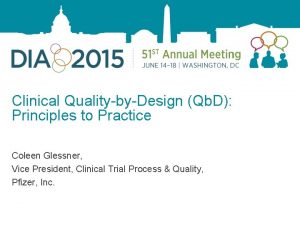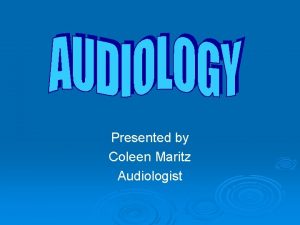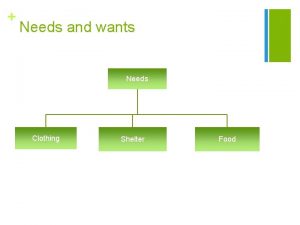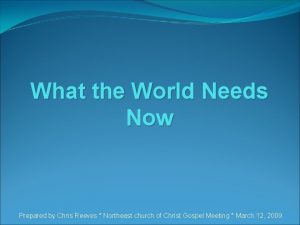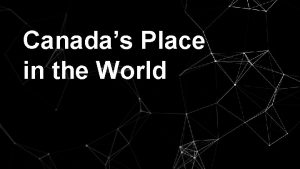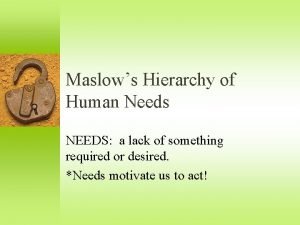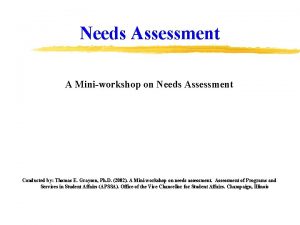What the World Needs Now Coleen Kivlahan MD

































- Slides: 33

What the World Needs Now Coleen Kivlahan, MD, MSPH Senior Director

Learning Objectives 2 • Explore what Americans want and need from their health system • Assess our progress in leading health system reform • Construct a template for the future that includes leading the charge to improve people’s abilities to live in dignity, peace and health

3

What Patients Value and Want? • Research on the patient experience has focused on patients in the hospital and other medical settings • Perceptions of people who do not self-identify as patients, a crosssectional descriptive study of adult volunteers, randomly selected at 4 settings in Washington, DC coffee shops, metro stops, senior centers, and community centers. • Asked to recall a positive and negative experience with health care and explain the factors that made it so; also asked what can be done to most improve health care in the U. S. • Half male/female, wide age range 20 -89 • 12 themes identified, with the three most cited as being critical to their health care experiences: • having a doctor who listens to them • is caring and compassionate • and who explains well. When people were asked about their health care experiences, they speak about the interaction between them and their doctors. The doctor-patient relationship remains at the heart of people’s perceptions of health care. 4 Wen, L. and Tucker, S. What Do People Want from Their Health Care? A Qualitative Study. The Journal of Participatory Medicine. Vol 7, 2015.

5

What Patients Can Expect of a Family Physician 6 • Give patients the care they need when they are most vulnerable • Care for patients regardless of age and health conditions, and work to sustain an enduring and trusting relationship with them • Be each patient’s first contact for health concerns • Address all their health concerns, and resolve most of them • Help patients with preventing, understanding, and managing illness • Navigate the health system with patients, including coordinating with specialists and staying connected with patients before, during, and after time spent in a hospital • Set health goals that adapt to each patient’s needs as defined by them • With the care team, use data and best science to prioritize and coordinate services most likely to benefit patients’ health • Use technology to maintain and enhance access, continuity, and relationships, and to optimize patients’ care and outcomes

And what do doctors want improved? The 3 Big A’s 1. Access 2. Affordability 3. Asinine Regulations “Many physicians are deeply anxious about the changes under way and are mourning real or anticipated losses of autonomy, respect, and income. They are being told that they must accept new organizational structures, ways of working, payment models, and performance goals. They struggle to care for the endless stream of patients who want. Bursts of rage over relatively small issues are common. ” 7

How would top doctors improve our health system? • Improve transparency • Understand gender differences • Actively promote prevention • Reward primary care • Partner with Silicon Valley • Embrace teams • Know patients’ values • Put health data to work • Support innovation • Make hospitals safe • Integrate care sites http: //www. aarp. org/healthy-living/info-2015/top-doctors-on-fixing-health-care. html 8

Even Insured Can Face Crushing Medical Debt, Study Finds Here is the surest way to enjoy the peace of mind that comes with having health insurance: Don’t Get Sick. In the new poll, conducted by The New York Times and the Kaiser Family Foundation, roughly 20 percent of people under age 65 with health insurance nonetheless reported having problems paying their medical bills over the last year. By comparison, 53 percent of people without insurance said the same. These financial vulnerabilities reflect the high costs of health care in the United States, the most expensive place in the world to get sick. NYTimes Jan 5 2016 9

Weakness of Fee for Service Payment Excessive use of low-value services 10 Insufficient incentives to improve quality of care Poor coordination of care

ACA Results: Higher Value, Lower Cost According to the Congressional Budget Office, federal spending on major health care programs in 2020 will be $200 Billion lower than predicted in 2010. 11

'Jaw-dropping': Medicare deaths, hospitalizations AND costs reduced Sample consisted of 68, 374, 904 unique Medicare beneficiaries (FFS and Medicare Advantage). 1999 2013 Difference All-cause mortality 5. 30% 4. 45% -0. 85% Total Hospitalizations/ 100, 000 beneficiaries 35, 274 26, 930 -8, 344 In-patient Expenditures/ Medicare fee-forservice beneficiary $3, 290 $2, 801 -$489 End of Life Hospitalization (last 6 months)/100 deaths 131. 1 102. 9 -28. 2 Findings were consistent across geographic and demographic groups. Mortality, Hospitalizations, and Expenditures for the Medicare Population Aged 65 Years or Older, 1999 -2013; Harlan M. Krumholz, MD, SM; Sudhakar V. Nuti, BA; Nicholas S. Downing, MD; Sharon-Lise T. Normand, Ph. D; Yun Wang, Ph. D; JAMA. 2015; 314(4): 355 -365. ; doi: 10. 1001/jama. 2015. 8035 12

Readmission Rate Medicare all-cause, 30 -day hospital readmission rate is declining Legend: CL: control limit; UCL: upper control limit; LCL: lower control limit 13

Target percentage of payments in ‘FFS linked to quality’ and ‘alternative payment models’ by 2016 and 2018 Alternative payment models (Categories 3 -4) FFS linked to quality (Categories 2 -4) All Medicare FFS (Categories 1 -4) 2011 2014 2016 2018 30% 50% 85% 90% 0% ~20% 68% >80% Historical Performance 14 Goals

15

Triangles Exercise • Stand up and come to the front of the room! • Pick out two people in the room and when I say go, you will follow them around the room, but you will attempt to stay equidistant from the whole time as they move around the room • OK, everyone have an eye on your two people? • GO! 16

CEOs expect and need leaders to be • Innovative • Visionary • Risk taking and entrepreneurial • Accept new care models • Consumer focused • Able to navigate change Yet many CEOs believe that our health systems lack risk takers and innovators, and that visionary physician leaders are scarce and in high demand! 17

What do we know about physician leadership? 18 • Doctors do not feel particularly well-equipped to provide the kind of leadership needed in today’s complex environment; skills are needed that are not acquired during medical training. • Medicine focuses on decision-making at the individual physician-patient level. • Leadership involves stepping away from that level and examining problems at a systems level, requiring the ability to view issues broadly and systemically • Many physicians truly can be considered “accidental leaders. ”

But aren’t we BORN leaders? 19 • Peter Drucker says “The first is that there may be ‘born leaders’, but there are surely too few to depend on them” • Leaders for our current and future health care environment need not be high charisma individuals who create followers through personal magnetism. They must be people who think and act “outside the box”, who can confront and challenge old patterns, and spearhead new ones.

Physician leader talent recruitment and retention 20 • Acquiring and developing talent is a critical success factor • Physicians/clinical leaders who connect with peers and help drive culture change • They make strategic decisions for organizations • They learn from, and often are, executive leaders from other industries • Leaders willing to take risks • IT and data scientists who anticipate questions and need

Leadership Defined Leadership is about taking risks. It is about having the courage of your convictions; about the will to act even in the face of powerful conventional wisdom, or strong opposition. It is not charisma, it is not management: management copes with complex organizations and ensures that things run well, that everyday problems are dealt with, and that there is a steady and continuous performance. Leadership requires visioning and motivating others to achieve a preferred result. It requires dealing with change, often unanticipated, unplanned change. John Kotter defines leadership by what leaders DO: -they cope with change -they set direction -they align people to participate in that new direction -and they motivate people 21

How do we learn to Lead? 22 • The best practices in leadership development are that one do not dissociate learning and doing. We enhance skills when we create “action learning” opportunities. • Evolving challenges and contexts facing us are the best ways to practice leadership. • To be effective leaders, we need to move from individual to systems thinking about the impact of our decisions and our work, and master the art of simultaneously paying attention to the dance floor and the balcony.

Core capacity #1: 23 • Leaders need to have the agility • to learn from the present while listening to both the balcony and the dance floor. • Ron Heifetz and his colleagues at Harvard gave us the image of the need for leaders to pay attention to both the dance floor in the heat of action and noise and also on the balcony looking down at the dance floor to gain a broader perspective. • This is a requirement for what they call adaptive leadership, the Complex Adaptive Leader.

Distinguishing Technical Problems and Adaptive Challenges Kind of Challenge 24 Problem Definition Solution Locus of Work Technical Clear Authority Technical & Adaptive Clear Requires Learning Authority & Stakeholders Adaptive Requires Learning Stakeholders Follow two people or Strep throat treatment One of you cross the room or stand on an X, Improve noshow rate Redesign primary care practice

Technical and Adaptive Problems 25 • Technical problems can be solved with knowledge and procedures already in hand. In contrast, adaptive challenges require new learning, innovation and new patterns of behavior. • Leadership is the activity of mobilizing people to address adaptive challenges • Adaptive challenges often appear as swamp issues—tangled, complex problems composed of multiple systems that resist technical analysis and differ from problems that are easier to address but where less is at stake for the organization or society. • Adaptive challenges call for more than change in routine: they call for changes of heart and mind, the transformation of longstanding habits and deeply held assumptions and values.

Time To Lead 26 • A typical primary care physician sees approximately 2000 patients, each of whom annually accounts for about $5000 for health care spending. • Although primary care accounts for only 5% of that spending, the decisions made in the primary care setting have important implications for downstream medical care, such as subspecialty referrals, imaging and other medical testing, invasive procedures, and hospitalizations. • A group of 100 adult primary care physicians could potentially influence almost $1 billion in health care spending. • Yet most physicians do not see themselves as a CEO. Physicians see opportunities every day to improve quality and lower costs, but the vast majority of physicians reported that they do not believe they have a central role in controlling costs.

“Primary care physician leadership is not a paradox; on the contrary, it’s hard to imagine health reform succeeding without family doctors at the helm. ” “Family physicians are personal doctors for people of all ages and health conditions. They are a reliable first contact…Through enduring partnerships, family physicians help patients prevent, understand, and manage illness, navigate the health system and set health goals…use data to monitor and manage their patient population…and science to prioritize services most likely to benefit health. They are ideal leaders of health care systems and partners for public health. ” Dr. Robert L. Phillips on the future role of the family physician in the May/June issue of Annals of Family Medicine 27

There Are So Many Opportunities for Physician Leaders 28 • CEO • Chief Innovation Officer • CMO • Chief Transformation Officer • Dean • Chairman/Faculty • Community provider, practice leader • State, National and Global policy • Research • Foundations

Gaps are Your Friend • Gaps between your aspiration as an individual or group and the current reality represents a leadership opportunity • People who tell us what we NEED to hear vs what we WANT to hear are leaders; it can be a dangerous but critical act • Leadership has NOTHING to do with position • Technical work lives in the head; adaptive work lives in the heart and gut • Leading change is about the distribution of loss. How will we minimize loss and articulate shared gains? • It is less about inspiration, and more about perspiration • Our world needs you to take more of the opportunities to act as a leader that confront you every day 29

The Antidote? • “Leaders at all levels must draw on reserves of optimism, courage, and resilience. They must develop an understanding of behavioral economics and social capital and be ready to part company with clinicians who refuse to work with their colleagues to improve outcomes and efficiency. ” • We must lead with the principles of: shared purpose, self-interest, respect, and tradition Engaging Doctors in the Health Care Revolution, Drs Tom Lee and Toby Cosgrove. June 2014. https: //hbr. org/2014/06/engaging-doctors-in-the-health-care-revolution. MD 30

31

32

33
 Coleen kivlahan
Coleen kivlahan Coleen kivlahan
Coleen kivlahan Coleen jackson
Coleen jackson Primary needs and secondary needs
Primary needs and secondary needs Primary needs and secondary needs
Primary needs and secondary needs Primary needs and secondary needs
Primary needs and secondary needs Strategic gender needs and practical gender needs
Strategic gender needs and practical gender needs Procedure of need analysis in esp
Procedure of need analysis in esp Dr faustus revision
Dr faustus revision Now i see it now you don't
Now i see it now you don't The world needs me
The world needs me World is now complete
World is now complete Hình ảnh bộ gõ cơ thể búng tay
Hình ảnh bộ gõ cơ thể búng tay Ng-html
Ng-html Bổ thể
Bổ thể Tỉ lệ cơ thể trẻ em
Tỉ lệ cơ thể trẻ em Gấu đi như thế nào
Gấu đi như thế nào Tư thế worms-breton
Tư thế worms-breton Hát lên người ơi
Hát lên người ơi Môn thể thao bắt đầu bằng từ chạy
Môn thể thao bắt đầu bằng từ chạy Thế nào là hệ số cao nhất
Thế nào là hệ số cao nhất Các châu lục và đại dương trên thế giới
Các châu lục và đại dương trên thế giới Công thức tính độ biến thiên đông lượng
Công thức tính độ biến thiên đông lượng Trời xanh đây là của chúng ta thể thơ
Trời xanh đây là của chúng ta thể thơ Mật thư tọa độ 5x5
Mật thư tọa độ 5x5 Phép trừ bù
Phép trừ bù Phản ứng thế ankan
Phản ứng thế ankan Các châu lục và đại dương trên thế giới
Các châu lục và đại dương trên thế giới Thể thơ truyền thống
Thể thơ truyền thống Quá trình desamine hóa có thể tạo ra
Quá trình desamine hóa có thể tạo ra Một số thể thơ truyền thống
Một số thể thơ truyền thống Cái miệng nó xinh thế
Cái miệng nó xinh thế Vẽ hình chiếu vuông góc của vật thể sau
Vẽ hình chiếu vuông góc của vật thể sau Nguyên nhân của sự mỏi cơ sinh 8
Nguyên nhân của sự mỏi cơ sinh 8
